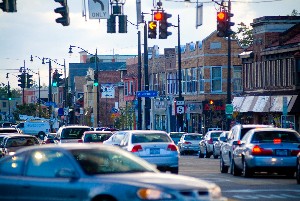Engineers at Oregon State University in Corvallis have identified more about the dangers faced by drivers and pedestrians alike when traffic lights turn yellow at intersections. The findings of transportation engineering professor David Hurwitz and colleagues from OSU and University of Massachusetts in Amherst appear in this month’s issue of the journal Transportation Research Part F: Traffic Psychology and Behaviour (paid subscription required).
The dilemma zone studied in this research refers to the area before a stoplight intersection where the traffic light turns yellow and the driver isn’t sure whether to stop or go ahead. “There are more than 30,000 traffic fatalities each year in the U.S., and about 2,000 of them occur in stoplight intersections,” says Hurwitz. “We think those crashes can be reduced with a better understanding of exactly where the dilemma zone is and how traffic lights and other technology can be adjusted to help manage it.”
Factors that lead to the problems in the dilemma zone include driving speed, distance to the stop light, driver skills, drivers who try to cross before the light turns red, and simple confusion by drivers who want to do the right thing but aren’t sure what it is. The phenomenon results in increased frequency of three types of accidents:
– Rear-end collision at the stop line
– Right-angle crashes in the intersections
– Left-turn head-on collisions
The last two accidents result from incorrect estimates of clearance time. The problems are exacerbated by laws that vary widely by state, often bringing drivers with different habits and expectations into the same intersection.
Hurwitz’s team devised what is called a fuzzy logic model, the name given to algorithms that derive exact decisions from inexact data. In this case, the variables range from drivers with very different skill sets and reaction times to automobile speeds and road conditions. The team based the model on empirical data collected at 10 high-speed intersections with traffic signals.
The findings better identified more precisely the dilemma zone that contributes to driver indecision. The results, say the authors, can help improve the timing of traffic signals and placement of vehicle detectors, which in turn can improve the safety of traffic intersections.
Read more: Algorithm Predicts Auto Traffic Intersection Violators
* * *


 RSS - Posts
RSS - Posts
You must be logged in to post a comment.